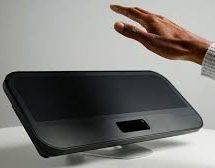Pioneers in spatial interaction merge for mutual benefit.

Did it seem Leap Motion got awfully quiet? Well it did, the company had seen its valuation drop and was clearly running out of money because the London-based Ultrahaptics announced plans to buy Leap Motion for $30 million, a comedown from higher ranges the company had seen in its younger days when it was valued at $300 million and more. In 2018, it looked as if Apple might buy Leap Motion for a rumored $30–50 million. Apple had made two different offers, but the two companies couldn’t come to terms. The execs at Leap Motion were not fans of Apple, and at the time, they seemed to think they had more options.
They had reason to think that. Leap Motion’s controllers had become incorporated in devices. It provided a straightforward option for headsets that were a technology in search of an interface. Leap Motion sensors gave people in headsets access to their hands to choices, click, etc. Unfortunately, life is tough out on the edge. The company’s customers were more often than not building products in AR and VR where sales numbers are low even if the cool-factor is high.
So, as it turns out, Leap Motion has been acquired by Ultrahaptics for $30 million. Ultrahaptics has a line of devices under the brand of Stratos that provide tactile feedback to users through ultrasound.
It’s a deal that makes sense. The companies have been partnering with Leap Motion enabling hand tracking for the Stratos devices and in fact the companies.
Most of the Leap Motion staff is going with the deal. However, CEO and co-founder Michael Buckwald will not stay.
In a prepared statement, Ultrahaptics’ CEO Steve Cliffe said, “Together, Ultrahaptics and Leap Motion products have the opportunity to be at the global epicenter of spatial interaction. Taking a holistic view of this exciting market, not only can we continue to create two hugely significant technologies, but we can max out the potential of combining them—proving that one plus one really can make three.”
What do we think?
Many people are saying that Leap Motion has sold for “only” $30 million and yes, that is a comedown from $300 million. But, as every kid selling baseball cards knows, you’re not really worth $300 million until someone gives you $300 million. It seems like $30 million is the number the company was destined to make after the failed deal with Apple.
And so far, spatial interaction has shown no signs of replacing mice and touch and more mainstream forms of human-machine interface. That could change, and it’s undeniably valuable for XR devices, but there are other options including handheld devices and as we’ve already said, the numbers aren’t huge.
From where we’re sitting, it’s a good outcome. Being acquired by Apple is often an aquihire situation with the actual technology trampled beneath Apple’s implacable trajectory. This merger of peers is more likely to advance interface technology for the wider community of XR development.
Editor’s note: In September 2019, Ultrahaptics changed its name to Ultraleap as the two companies move forward as one. In their statement on the website, Ultraleap says: “As world leaders in mid-air haptics and hand tracking, Ultrahaptics and Leap Motion are accelerating innovation in user interfaces and enhancing commercial software and hardware applications. The new corporate brand, Ultraleap, represents a significant step forward for the combined group, while reflecting the company’s dual roots.”






